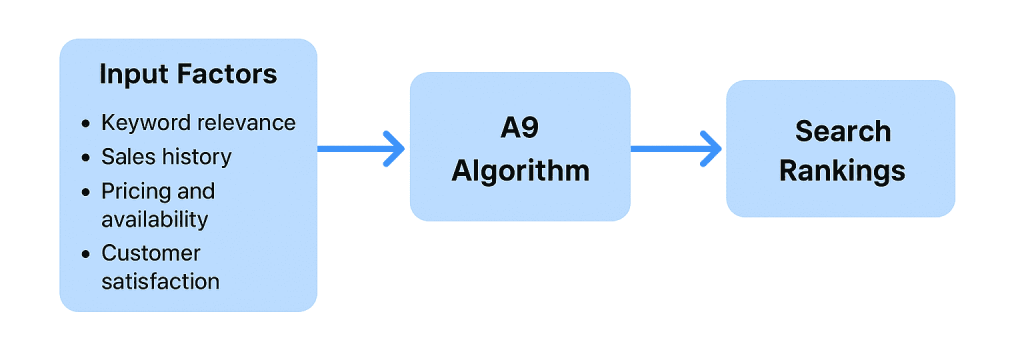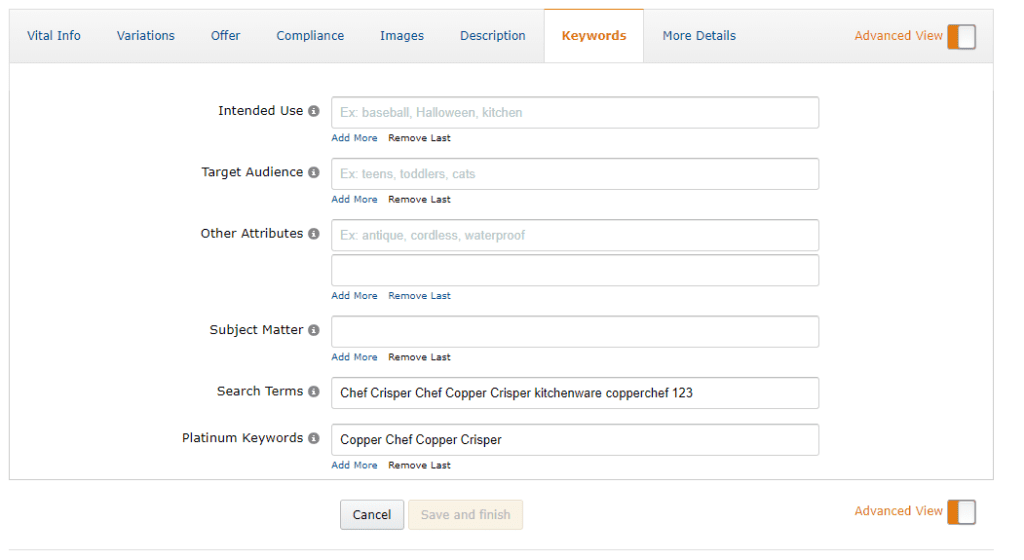Amazon is dominating the e-commerce world in 2025. There are so many sellers on Amazon that compete for the buyer’s attention. Every seller wants to stand top in this crowded marketplace, but it seems to be difficult unless you are aware of Amazon SEO.
Optimizing your listing not only uplifts your product visibility but also gives a boost to your sales. SEO on Amazon isn’t just about keywords, it’s about creating a product page that converts visitors into buyers while aligning with Amazon’s goals.
In this blog post, we’ll cover the top Amazon SEO strategies that can help you rank higher and sell faster in 2025.
Understanding Amazon’s A9 Algorithm
Amazon A9 is known as The search engine of Amazon. It operates with just a goal that is to maximzing conversions.
Just as Google which aims to provide the best information, Amazon algorithm main purpose is to showing products that are most likely to be purchased.

Here’s how A9 evaluates products that are essential for Amazon SEO:
- Keyword relevance: If your product listing matches the customer’s search term, it’s more likely to appear. That’s why using the right keywords in titles, bullet points, and backend fields is crucial.
- Sales history: Products that have a strong history of sales are given priority. Amazon assumes that if a product sold well before, it will continue to satisfy future customers.
- Pricing and availability: Competitive pricing and having products consistently in stock impact your chances of ranking high.
- Customer satisfaction metrics: Metrics like reviews, return rates, and shipping speed are all indicators that Amazon uses to assess the likelihood of customer satisfaction.
By keeping in mind these factors before creating your Amazon SEO strategies can help you in boosting your conversions and sales.
Keyword Research for Amazon Listings
For success in Amazon SEO, you have to do a good and effective keyword research. Unlike general SEO, where you target informational queries, Amazon keywords are, purchase-driven, users are ready to buy.
To perform effective keyword research for Amazon SEO, you must follow the following points:
- Use specialized tools: You can find keywords based on actual Amazon search volumes by using tools like SellerApp, Helium 10, Jungle Scout, and AMZScout. These tools also help you in competitor analysis, so you can know on which keywords your competitors are ranking for.
- Analyze competitor listings: Focus on the top products in your category. What keywords are they using, their titles, and descriptions? They can help you identify the keywords for your product SEO.
- Amazon’s autocomplete: When you start typing a product name into Amazon’s search bar, Amazon suggests popular searches. These suggestions are gold for finding buyer-driven keywords.

Autocomplete suggestions on Amazon
- Use long-tail keywords: Use long-tail keywords instead of short keywords because long-tail keywords often convert better and face less competition. For example, instead of “wireless earbuds,” use “wireless earbuds for exercise or running.”
Optimizing Product Listings for Maximum Visibility
If you find the right keywords, now it is the turn to place them in your product listing. Amazon SEO optimization isn’t just about stuffing keywords, but making a listing that attracts customers and ranks you on top.
The following gives you the roadmap to optimize your Amazon listing properly:
- Title optimization: Place your primary keyword at the beginning. Titles should be clear, descriptive, and highlight the biggest selling points (like size, color, quantity, or a unique feature).
- Bullet points: Use bullet points to highlight the top benefits of your product. Keep each bullet punchy and easy to skim. Incorporate secondary keywords naturally without forcing them.
- Product description: This is where you can dive deeper into the product’s story, brand mission, and detailed use cases. Break the text into short paragraphs for better readability.
- High-quality images and videos: Amazon allows multiple images and even short videos. Use professional images showing different angles, features, and the product being used in real life.

An SEO optimized product description on Amazon
Hidden SEO Factors
The hidden Amazon SEO factors are pricing, reviews and seller metrics. Many sellers wrongly believe that SEO stops at keywords. In reality, your pricing strategy, customer reviews, and performance metrics heavily impact your search rankings.
Here’s how each factor matters:
- Pricing: Amazon wants competitive pricing because it leads to higher conversions. Overpriced items tend to fall lower in search rankings unless they offer something truly unique.
- Reviews: Products with a high volume of positive reviews not only convert better but also rank better. Invest time in post-purchase emails (Amazon compliant) and programs like Amazon Vine to collect reviews.
- Seller performance: Metrics like order defect rate (ODR), late shipments, and cancellation rates tell Amazon how reliable you are—key indicators that influence your success with online earning solutions. High-performing sellers are rewarded with better visibility.
Using Backend Keywords Correctly
Backend keywords are concealed keywords that are exclusive to Amazon sellers. Although visitors are unable to view these keywords, they serve to inform Amazon’s algorithm that a particular keyword pertains to your listing. Backend keywords are the “invisible” Amazon SEO fields that can make or break your listing’s performance.
Tips for mastering backend keywords:
- Be strategic: Use synonyms, related terms, and common misspellings that buyers might type.
- Avoid duplication: If a keyword is already in your title or bullets, don’t repeat it here — Amazon ignores duplicates.
- No competitor brand names: Avoid the temptation to include your competitor’s brand. Amazon strictly forbids it and it could result in penalties.
- Use the full character limit: Amazon gives you around 249 bytes for backend search terms — use them wisely without stuffing irrelevant keywords.

Using Amazon PPC
Running Amazon PPC (pay-per-click) ads can boost your organic rankings over time by increasing your sales, clicks, and product visibility.
Here’s how to use Amazon PPC smartly:
- Start with Sponsored Products: These ads are simple to set up and highly effective for driving traffic to individual listings.
- Target high-intent keywords: Bid on keywords that are closely related to your product to maximize conversions.
- Analyze and optimize: Monitor your advertising cost of sales (ACOS) regularly. Advanced Amazon PPC automation solutions can continuously identify underperforming keywords, automatically pausing those draining your budget without returns.
- Gradually scale: Once you find winning campaigns, slowly increase the budget to drive even more sales and visibility.
Managing Your Amazon Business Smartly to Support SEO Growth
A successful Amazon business isn’t just about ecommerce marketing, it’s also about operational excellence. Sellers who manage inventory smartly, track finances accurately, and avoid disruptions tend to rank higher in the long run.
Key areas to focus on:
- Inventory Management: Running out of stock hurts your SEO rankings severely. Plan inventory replenishments in advance, especially during peak seasons.
- Financial Management: Keep track of all your expenses, fees, and payouts. Using a reliable Amazon accounting software can help you automate bookkeeping, manage cash flow, and focus more on scaling.
- Customer Support: Respond promptly to customer messages and resolve any issues quickly. Good customer service builds your brand and improves seller metrics.
Amazon SEO Trends in 2025
There is a lot of competition in Amazon selling today. Sellers who adapt the latest trends will dominate.
Here are key trends you should prepare for:
- AI-driven personalization: Amazon is using AI more than ever to personalize search results based on each buyer’s behavior. Sellers should focus on improving relevancy and customer engagement.
- Brand authority matters: Amazon is prioritizing brands with established storefronts, A+ Content, and strong customer loyalty.
- Voice search optimization: With Alexa devices becoming common, optimizing listings for conversational queries (like “best running shoes for men”) can give sellers an edge.
- Sustainability focus: Products that highlight eco-friendliness and transparency in sourcing are gaining visibility and favor from Amazon.
Staying agile, learning, and adapting are now part of every seller’s SEO playbook.
Conclusion
Succes on Amazon in 2025 requires more than just listing a product and hoping to sell your product. It demands to apply the Amazon SEO strategies like smart keyword research, optimizing listings with precision, and maintaining operational excellence.
If you stay committed to these strategies, you’ll not only rank higher but also build a long-term, thriving Amazon business.



